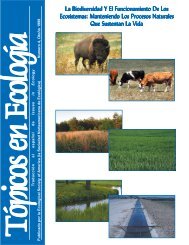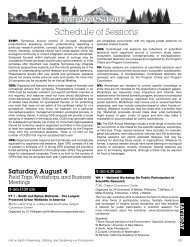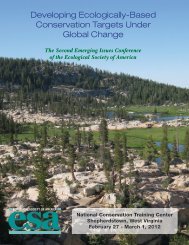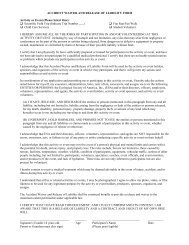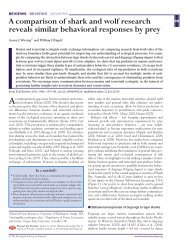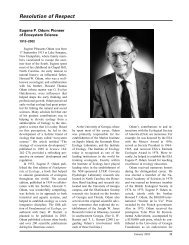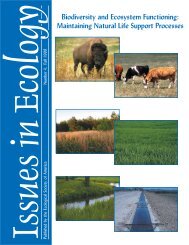Printed Program (PDF) - Ecological Society of America
Printed Program (PDF) - Ecological Society of America
Printed Program (PDF) - Ecological Society of America
You also want an ePaper? Increase the reach of your titles
YUMPU automatically turns print PDFs into web optimized ePapers that Google loves.
FRIDAY<br />
8:30 am-10:30 am<br />
PS 109-237 D’Aguillo, MC1, AS Harold1, WA Roumillat2, DM Wyanski2<br />
and TL Darden2, (1)College <strong>of</strong> Charleston Grice Marine<br />
Laboratory, (2)South Carolina Department <strong>of</strong> Natural<br />
Resources. Detection <strong>of</strong> an ontogenetic diet shift in the<br />
naked goby, Gobiosoma bosc.<br />
PS 109-238 Faulkes, Z and TP Feria, The University <strong>of</strong> Texas-Pan<br />
<strong>America</strong>n. Size differences in sand crabs living in the Gulf <strong>of</strong><br />
Mexico and the Atlantic Ocean.<br />
PS 109-239 Bollens, SM1, JK Breckenridge1, GC Rollwagen-Bollens1,<br />
JR Cordell2 and O Kalata2, (1)Washington State University<br />
Vancouver, (2)University <strong>of</strong> Washington. Non-indigenous<br />
copepods and plankton dynamics <strong>of</strong> the lower Columbia<br />
River Estuary.<br />
PS 109-240 Epps, EBC and R Jude, University <strong>of</strong> Georgia. Symbiosis<br />
and stress in a thermally tolerant coral.<br />
PS 109-241 Nelson, JL and ES Zavaleta, University <strong>of</strong> California,<br />
Santa Cruz. Salt marsh as a coastal filter: An estuary-wide<br />
observational study.<br />
PS 110 - Latebreaking: Microbial Ecology<br />
Exhibit Hall DE, Oregon Convention Center<br />
PS 110-242 Raizen, NL1 and NJ Grunwald2, (1)Oregon State University,<br />
(2)USDA ARS Horticultural Crops Research Laboratory.<br />
Metagenomic diversity <strong>of</strong> foliar fungal endophyte<br />
communities in Rhododendron.<br />
PS 110-243 Heneghan, DA, IA Hansen, WJ Boecklen and AC James,<br />
New Mexico State University. Evidence against the presence<br />
<strong>of</strong> Wolbachia in the crayfish species, Orconectes virilis and<br />
Procambarus clarkii.<br />
PS 110-244 Looby, C1, KL McGuire2 and B Eaton1, (1)Kean University,<br />
(2)Barnard College, Columbia University. Effects <strong>of</strong> Bromelia<br />
pinguin (Bromeliaceae) on soil ecosystem function in primary<br />
forests <strong>of</strong> Costa Rica.<br />
PS 110-245 Lange, RK, G Rocap and MC Horner-Devine, University <strong>of</strong><br />
Washington. Living in the dead zone: Patterns <strong>of</strong> bacterial<br />
communities in Hood Canal, WA, USA.<br />
PS 110-246 Atkinson, SD and JL Bartholomew, Oregon State University.<br />
Estimating species richness <strong>of</strong> myxozoan parasites (Phylum<br />
Myxozoa) in the Pacific Northwest.<br />
PS 110-247 Kirk, JK, JR Goldberger, KE Judd, SN Francoeur and DL<br />
Clemans, Eastern Michigan University. Effect <strong>of</strong> invasion and<br />
control <strong>of</strong> Phragmites australis on soil microbial community<br />
composition and abundance in Great Lakes coastal<br />
wetlands.<br />
PS 110-248 Zlamal, JE, DN Goria and DA Lipson, San Diego State<br />
University. The interaction <strong>of</strong> iron and humic substances in<br />
the Arctic environment.<br />
PS 110-249 Weisenhorn, P, University <strong>of</strong> Minnesota. Relationship<br />
between phylogenetic distance and growth rates <strong>of</strong> soil<br />
bacterial isolates in culture.<br />
PS 111 - Latebreaking: Modeling<br />
Exhibit Hall DE, Oregon Convention Center<br />
PS 111-250 Aycrigg, JL1, J Lonneker1, M Rubino2, N Tarr2, KG Boykin3,<br />
A McKerrow4, GP Beauvais5, T Gotthardt6 and WA Gould7,<br />
(1)University <strong>of</strong> Idaho, (2)Biodiversity and Spatial Information<br />
Center, (3)New Mexico State University, (4)United States<br />
Geological Survey, (5)University <strong>of</strong> Wyoming, (6)Alaska<br />
Natural Heritage <strong>Program</strong>, (7)International Institute <strong>of</strong><br />
Tropical Forestry. Modeling vertebrate species in the US:<br />
Species modeling efforts <strong>of</strong> the Gap Analysis <strong>Program</strong>.<br />
PS 111-251 Brito, I and E Alm, Massachusetts Institute <strong>of</strong> Technology.<br />
Tracking microbes within communities.<br />
PS 111-252 Phillips, AJ and M Kot, University <strong>of</strong> Washington. Estimating<br />
population persistence in a warming world: Incorporating 2D<br />
space into mathematical models.<br />
PS 111-253 Renton, M, N Shackelford and RJ Standish, University<br />
<strong>of</strong> Western Australia. Dynamic modelling to predict the<br />
likelihood <strong>of</strong> plant species persistence under climate change.<br />
PS 111-254 Hayduk, E1, J Cushing1, J Walley1 and K Winters2, (1)<br />
The Evergreen State College, (2)Oregon State University.<br />
How ecologists “visualize” research results in publications:<br />
VISTAS Project ecology journal survey.<br />
PS 111-255 Gounand, I1, N Mouquet1, E Canard2, C Hauzy3, F<br />
Guichard4 and D Gravel5, (1)Université Montpellier 2, CNRS,<br />
(2)Institut des Sciences de l’Evolution de Montpellier, (3)<br />
Université Pierre et Marie Curie (Paris 6), (4)McGill University,<br />
(5)Université du Québec à Rimouski. The paradox <strong>of</strong><br />
enrichment in metaecosystems.<br />
PS 111-256 Harsch, MA, Y Zhou and M Kot, University <strong>of</strong> Washington.<br />
The most critical part <strong>of</strong> a plant’s life cycle for persisting in a<br />
warming climate.<br />
PS 111-257 Kirk, AK and R Isaacs, Michigan State University.<br />
Modeling the pollination <strong>of</strong> highbush blueberry (Vaccinium<br />
corymbosum) to explore varying pollination strategies.<br />
PS 111-258 Naithani, K1, EAH Smithwick1, KJ Davis1, K Keller1, RE<br />
Kennedy2 and JG Masek3, (1)The Pennsylvania State<br />
University, (2)Oregon State University, (3)NASA. Incorporation<br />
<strong>of</strong> disturbance and seasonality in terrestrial carbon flux<br />
upscaling.<br />
PS 111-259 Timilsina, N1, F Escobedo1, CL Staudhammer2, T Brandeis3<br />
and W Zipperer3, (1)University <strong>of</strong> Florida, (2)University <strong>of</strong><br />
Alabama, (3)USDA Forest Service. Identifying drivers <strong>of</strong><br />
carbon using structural equation modeling in a subtropical<br />
urban forest.<br />
PS 111-260 Romero, TS, The University <strong>of</strong> Texas Pan<strong>America</strong>n. Present<br />
and future distribution <strong>of</strong> Neotoma micropus, reservoir <strong>of</strong><br />
Chagas and leishmaniasis diseases, in North <strong>America</strong>.<br />
PS 111-261 Butler, CA1, CP McGowan2, JB Grand3 and DR Smith4,<br />
(1)Auburn University, (2)U.S. Geological Survey, Alabama<br />
Cooperative Fish and Wildlife Research Unit, (3)USGS<br />
Alabama Cooperative Fisheries and Wildlife Research Unit,<br />
(4)United States Geological Survey, Leetown Science Center.<br />
Estimating tag loss <strong>of</strong> the Atlantic Horseshoe crab, Limulus<br />
polyphemus, using a multi-state model.<br />
PS 111-262 Tuckfield, RC1, MC Belk2 and JS Wesner2, (1)ECOSTATys<br />
LLC, (2)Brigham Young University. Right-wing and leftist<br />
views <strong>of</strong> modeling community complexity.<br />
PS 112 - Latebreaking: Physiology<br />
Exhibit Hall DE, Oregon Convention Center<br />
PS 112-263 Rosenthal, DM1, RA Slattery2, RE Miller3, TA Cavagnaro3,<br />
RM Gleadow3, AK Grennan2, CM Fauquet4 and DR Ort5,<br />
(1)USDA-ARS, (2)University <strong>of</strong> Illinois, (3)Monash University,<br />
(4)Donald Danforth Plant Science Center, (5)USDA-ARS and<br />
University <strong>of</strong> Illinois. Cassava about-FACE: Greater than<br />
expected yield stimulation <strong>of</strong> cassava (Manihot esculenta) by<br />
future CO2 levels.<br />
PS 112-264 Savage, JA, NM Holbrook and M Zwieniecki, Harvard<br />
University. The dynamic nature <strong>of</strong> phloem transport in<br />
seedlings: Growth, phenology and environmental stimuli.<br />
PS 112-265 Fincher, RM, GL Gentry and RL Hunsinger, Samford<br />
University. Cooling in a fungal- Cecidomyiid gall on the<br />
undererstory shrub Symplocos tinctoria.<br />
PS 112-266 White, RSA1, CN Glover1, PA McHugh2 and AR McIntosh1,<br />
(1)University <strong>of</strong> Canterbury, (2)Washington Department <strong>of</strong><br />
Fish & Wildlife. Powerful fish in poor environments: Metabolic<br />
scaling <strong>of</strong> fish across a wetland-floodplain.<br />
PS 112-267 Hughes, NM, CN Miller and S Keidel, High Point University.<br />
Photosynthetic costs and benefits <strong>of</strong> adaxial/abaxial leaf<br />
reddening in understory plants.<br />
PS 112-268 Melnychenko, AN, Portland State University. Bamboo and<br />
BVOCs: Exploring the interplay between isoprene emission<br />
and physiology.<br />
PS 112-269 Sack, L1, C Sc<strong>of</strong>foni2 and GP John3, (1)UCLA, (2)University<br />
<strong>of</strong> California Los Angeles, (3)University <strong>of</strong> California, Los<br />
Angeles. The anatomical basis <strong>of</strong> leaf water relations across<br />
diverse species.<br />
PS 112-270 Walker, JKM, H Cohen, LM Higgins and PG Kennedy, Lewis<br />
& Clark College. Does the physiology <strong>of</strong> fungal symbionts<br />
drive specificity in Alnus-ectomycorrhizal assemblages.<br />
PS 112-271 Reid, CD1, CR Howell1, A Weisenberger2, S Lee2, C Zorn2,<br />
A Crowell1, G Bonito1, M Smith3, J McKisson2, J McKisson2<br />
and W Xi2, (1)Duke University, (2)Thomas Jefferson National<br />
Accelerator Facility, (3)University <strong>of</strong> Maryland. Using<br />
PhytoPET imaging to elucidate trade-<strong>of</strong>fs in plant-fungal<br />
symbiont interactions.<br />
PS 112-272 Anderson, S1, S Wyllie-Echeverria2 and AP Summers2, (1)<br />
Friday Harbor High School, (2)University <strong>of</strong> Washington.<br />
Location <strong>of</strong> seed coat split prior to germination: An SEM<br />
investigation <strong>of</strong> Zostera marina seed.<br />
190 ESA 97th Annual Meeting, August 5 - 10, 2012, Oregon Convention Center



